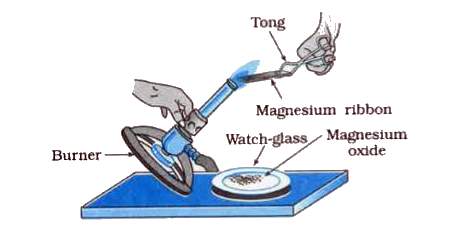Aim: To study the burning of magnesium ribbon in air.
Caution : It is necessary that this activity should be performed in the presence of a teacher. For safety purpose, teacher and student should wear goggles.
Activity:
Take approximately 3-4 cm long magnesium ribbon and make it clean by rubbing it with sand paper.
Hold it with a pair of tongs and heat on the flame of burner or spirit lamp and the ash being formed collects in the watch-glass as shown in the figure 1.1.
Collected ash in the watch-glass is of magnesium oxide.
Burn the magnesium ribbon. Keeping it away as far as possible from your eyes.

Why is magnesium ribbon selected ?
Text Solution
Magnesium ribbon is highly reactive and burns easily in air.
|
Topper's Solved these Questions
- CHEMICAL REACTIONS AND EQUATIONS BOOK - KUMAR PRAKASHANCHAPTER - CHEMICAL REACTIONS AND EQUATIONS EXERCISE - QUESTIONS AND ANSWERS (ACTIVITY 1.2)
5 Videos
- CHEMICAL REACTIONS AND EQUATIONS BOOK - KUMAR PRAKASHANCHAPTER - CHEMICAL REACTIONS AND EQUATIONS EXERCISE - QUESTIONS AND ANSWERS (ACTIVITY 1.3)
4 Videos
- CHEMICAL REACTIONS AND EQUATIONS BOOK - KUMAR PRAKASHANCHAPTER - CHEMICAL REACTIONS AND EQUATIONS EXERCISE - QUESTIONS AND ANSWERS Intext Questions
4 Videos
- CARBON AND ITS COMPOUNDSBOOK - KUMAR PRAKASHANCHAPTER - CARBON AND ITS COMPOUNDSEXERCISE - Practical Skill Based Questions With Answers
10 Videos
- METALS AND NON-METALSBOOK - KUMAR PRAKASHANCHAPTER - METALS AND NON-METALSEXERCISE - PRACTICE SKILL BASED QUESTIONS WITH ANSWERS
5 Videos
Similar Questions
Knowledge Check
Buring of a magnesium ribbon in air takes place with
Aa green flameBa yellow flameCa dazzling white lightDan orange flameBuring of a magnesium ribbon in air takes place with
Aa green flameBa yellow flameCa dazzling white lightDan orange flameOn burning magnesium ribbon in air, it is observed that
Aa greenish gas is obtainedBit burns brightly, giving golden colourCit burns brightly, leaving a blue ashDit burns brightly, leaving behind a white powder
Why should a magnesium ribbon be cleaned before burning in air ?
View SolutionWhy should a magnesium ribbon be cleaned before burning in air?
View SolutionThe burning of a piece of magnesium ribbon in air is a chemical change. Explain.
View SolutionA burning magnesium ribbon will continue to burn in
View SolutionWhen magnesium ribbon burnt, it produces :
View Solution
